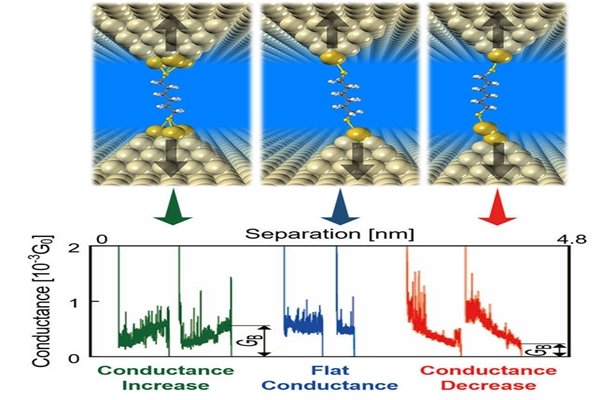KAIST (Korea Advanced Institute of Science & Technology, President Shin Sung-chul) succeeded in discovering interfacial properties of single molecular devices, which had been a challenge in nano-field for more than 10 years. It has increased credibility of single molecular devices and prepared a new turning point that will control properties of organic devices such as OLED, bio-sensors, and organic solar batteries that have molecules clustered.
KAIST announced on the 4th that a research team led by Professor Kim Yong-hoon of EEWS Graduate School discovered metal electrode-molecule interface autonomic structure and properties of single molecule electronic devices through computer simulations and testing.
Single molecule electronic device is a device that implements small molecules instead of silicon into monomers. It uses nanometer-sized molecule and it can manufacture high-density devices at a moderate price. It is seen as one of the candidates for next-generation semiconductor device. However no one was able to implement interfacial properties that are required to implement devices. Number, size, and cause of current values that can be shown through molecular devices had remained as unknown. Molecular electronic device is largely composed of molecule, electrode, and coupler and no one was able to discover atomic structure and properties of these molecule, electrode, and coupler. Because current value of a device could not be estimated, credibility could not be secured.

Research team was able to reenact a process of implementation of single molecular device through a supercomputer. By using alkene molecule, gold electrode, and sulfur atom, which is the coupler, it was able to confirm ‘multi-conductivity’ phenomenon where each single molecular device has different current value from each other.
Research team also worked with a research team from Osaka University and carried out testing that backed up results from reenactment. Through tensile experiment, it proved that conductivity changes depending on coupling of metal electrode and atomic structure. Conductivity increased when there were 3 gold atoms near a sulfur atom. However conductivity did not change when number of gold atoms decreased to one by increasing tensile speed. Conductivity decreased when tensile strength became higher.
Research team explained that this research will push forward timing when single molecular electronic device becomes a reality. It is also going to be much easier to predict characteristics of organic devices that have molecules clustered. Research team is going to expand an area of its research by using different atoms and metal electrodes in the future.
“We are able to understand interfacial properties of single molecular devices that could not be done before and increased credibility of these devices.” said Professor Kim Yong-hoon. “This research can also be used for variety of organic devices such as OLED, bio-sensors, and organic solar batteries.”
Staff Reporter Kim, Youngjoon | kyj85@etnews.com